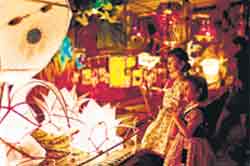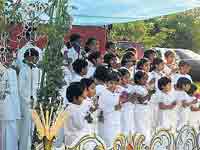| Vesak
- a multi-faceted festival |

 Simplicity
is the keyword for Vesak. All devotees wear white and avoid coloured
clothes. All Buddhists whether they observe sil or not, will refrain
from eating fish, meat or eggs on Vesak day. They all prefer a simple
vegetarian meal. In fact, many of them will remain vegetarian for
a whole week or even throughout the month of Vesak. They will sit
on mats and listen to bana and par take of the alms. Those who find
it difficult to sit on the floor will use a low stool or a chair,
rather reluctantly. Simplicity
is the keyword for Vesak. All devotees wear white and avoid coloured
clothes. All Buddhists whether they observe sil or not, will refrain
from eating fish, meat or eggs on Vesak day. They all prefer a simple
vegetarian meal. In fact, many of them will remain vegetarian for
a whole week or even throughout the month of Vesak. They will sit
on mats and listen to bana and par take of the alms. Those who find
it difficult to sit on the floor will use a low stool or a chair,
rather reluctantly.
The day begins with a resident monk in the temple reciting the eight
precepts, one at a time with the devotees repeating the words after
the monk thereby observing the precepts. This will be followed by
a short sermon when the monk discusses the significance of Vesak.
Even though everyone would be well aware of the importance of the
day, the sermon would help them to refresh their memories. The Buddha
puja is held in the budu ge with flowers, incense and food items
being offered to the Buddha. The monks are then offered the heel
dana (morning alms) and the devotees too would partake of their
food.
Monks who have earned a reputation for eloquent preaching have a
busy day on Vesak day being picked up from one temple to another
to deliver sermons. In addition to sermons, there will be guided
meditation by monks well versed in the subject and the devotees
would then spend time meditating on their own until the mid-day
dana time. The morning routine would be followed and the devotees
would take a short rest after their own dana. They would then listen
to more sermons, chant pirith and participate in gilan pasa puja
in the evening when only offerings in liquid form are made in keeping
with the practice of avoiding solids after noon.
 Most devotees would spend the night at the temple itself and return
home only the following morning having completed a full 24-hour
observance of ata sil. The ending of ata sil is marked by observing
pan sil thereby getting back to the routine of the five precepts.
Most devotees would spend the night at the temple itself and return
home only the following morning having completed a full 24-hour
observance of ata sil. The ending of ata sil is marked by observing
pan sil thereby getting back to the routine of the five precepts.
Vesak is a time for giving. The numerous dansalas seen by the roadside
symbolize the concept of giving. Vehicles would be stopped and offered
at least a soft drink. Many would be given a sumptuous meal at noon.
The servings continue late into the night with crowds getting about
to see the illuminations and pandals.
Vesak is also a festival of lights. Every home will light pol thel
pahan and lanterns as offerings to the Buddha. Elaborate Vesak koodus
are a big attraction with one huge lantern surrounded by a host
of smaller lanterns are made to circle round, forming a beautiful
sight. Hundreds of bulbs are used in pandals when a Jataka story
or a chapter from the Buddha's life story is depicted through colourful
paintings and the story related through loud speakers often taking
the form of a dialogue drama. Street performances are another familiar
sight when youngsters wearing masks - generally called olu bakko
- present skits providing light entertainment.
|
 Simplicity
is the keyword for Vesak. All devotees wear white and avoid coloured
clothes. All Buddhists whether they observe sil or not, will refrain
from eating fish, meat or eggs on Vesak day. They all prefer a simple
vegetarian meal. In fact, many of them will remain vegetarian for
a whole week or even throughout the month of Vesak. They will sit
on mats and listen to bana and par take of the alms. Those who find
it difficult to sit on the floor will use a low stool or a chair,
rather reluctantly.
Simplicity
is the keyword for Vesak. All devotees wear white and avoid coloured
clothes. All Buddhists whether they observe sil or not, will refrain
from eating fish, meat or eggs on Vesak day. They all prefer a simple
vegetarian meal. In fact, many of them will remain vegetarian for
a whole week or even throughout the month of Vesak. They will sit
on mats and listen to bana and par take of the alms. Those who find
it difficult to sit on the floor will use a low stool or a chair,
rather reluctantly. Most devotees would spend the night at the temple itself and return
home only the following morning having completed a full 24-hour
observance of ata sil. The ending of ata sil is marked by observing
pan sil thereby getting back to the routine of the five precepts.
Most devotees would spend the night at the temple itself and return
home only the following morning having completed a full 24-hour
observance of ata sil. The ending of ata sil is marked by observing
pan sil thereby getting back to the routine of the five precepts.